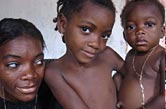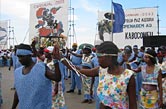by Khadija Magardie
May 28, 2003
Can AIDS be compared to a ticking time bomb, poised to explode among the people of Angola? Find out in our briefing (below) by South African journalist, Khadija Magardie.
Peace appears to have finally come to Angola. A May 2002 cease-fire between the Angolan government and the rebel forces of the National Union for the Total Independence of Angola (UNITA) has brought calm to a country that, for nearly three decades, was trapped in a spiraling conflict. Thousands of Angolans who fled the fighting are voluntarily returning home, but the social, economic, and political chaos of war is being replaced by a new menace, AIDS.
Angola’s post-war reconstruction period could prove to be the calm before the storm. Throughout sub-Saharan Africa, conflict has catalyzed the spread of HIV; the human dislocation caused by war fuels the spread of the disease. In January 2000, U.N. Secretary-General Kofi Annan told the U.N. Security Council that the impact of AIDS in Africa was “no less destructive than that of warfare itself,” and would, as more and more populations were impacted, cause “social and economic crises which in turn threaten political stability.”
See more facts In the 1960s, when Angola was still a Portuguese colony, the Popular Movement for the Liberation of Angola (MPLA) mounted its first battle for the independence of the country. An ethnically-based nationalist movement, called the National Union for the Total Independence of Angola (UNITA), also formed during this period. The MPLA was supported by the Soviet Union and Cuba and UNITA was backed by South Africa and the United States. When Portugal relinquished power in 1975, Angola tumbled into chaos. Eventually the MPLA was recognized by the U.N. as Angola’s official government — a situation that UNITA never accepted. For the next 27 years, the MPLA and UNITA battled for control. The cost was high: nearly 500,000 Angolans lost their lives, while millions more fled their homes during the fighting.
In 1992, hostilities were temporarily halted while the country attempted a multi-party election. But close results between the incumbent, Jose Eduardo Dos Santos of the MPLA, and UNITA leader, Jonas Savimbi, brought the country back to war. It wasn’t until the battlefield death of Savimbi in 2002 that the wartorn country finally found peace.
Until recently, civil war effectively prevented the spread of the AIDS epidemic by isolating Angola from neighboring countries with high HIV rates. But the war also cut the country off from HIV awareness and education campaigns. Consequently, HIV/AIDS was not identified as a serious problem in Angola. This all is changing. Although the country’s HIV prevalence rates are lower than those in neighboring countries like Zimbabwe, Congo, and Zambia, they are steadily increasing.
The U.S.-based Centers for Disease Control (CDC) estimates that, in 1998, around four percent of the population was HIV-positive and some 200,000 Angolans were living with HIV. Today, estimates suggest between 500,000 and 1,000,000 people are now infected — some six percent of the population
The end of civil war and the return of displaced persons to their homes may bring a semblance of normalcy to Angola, but the returning refugees are also part of a new problem. According to a report by Reuters, Angola’s newfound peace may actually encourage the kind of risk factors that lead to an HIV/AIDS explosion:
“… high displacement rates, coupled with massive population movements of internally displaced people, returning refugees, ex-UNITA and Angolan army members; low education levels (more than 1 million children are out of school); a destroyed health infrastructure; and the disintegration of social structures, which results in women being forced to exchange sex for survival.”
War has had a devastating impact on Angola; its infrastructure has been bombed away. In a country where even basic services are a luxury, international relief agencies like the Red Cross and the United Nations Development Programme (UNDP) are only now able to operate relatively freely. Which explains why exact HIV/AIDS figures in Angola are hard to come by. It is only now, with the opening up of Angola, that the true impact of AIDS can be assessed. Yet what Angola may discover is that years of neglect, coupled with a swelling population of possibly-infected, returning refugees, constitute an HIV time bomb.
NO UNIQUE PROBLEM?
In a sense, Angola is facing a wider problem that is currently affecting all of sub-Saharan Africa. While only a tenth of the world’s population lives in this region, nearly 70 percent of the world’s population of people infected with HIV are concentrated here. And these populations often mix. At present, there are approximately 450,000 Angolan refugees living in Zambia, Namibia, and Botswana, many of whom are now planning to return home.
According to the UNHCR’s regional offices, nearly 100,000 refugees have already returned to Angola. But it would be “irresponsible,” cautions Fidellis Swai, the UNHCR regional spokesman, to suggest that rising HIV prevalence rates in Angola are solely being caused by returning refugees. The disease is “a problem of the region, and should not be used to stigmatize a particular group,” he says. “It’s a clich� we’re trying to battle with: refugees are blamed for everything bad that happens in society.”
COULD AIDS DESTABILIZE ENTIRE COUNTRIES?
The South Africa-based Institute for Security Studies (ISS), which has published research on the impact of AIDS on security and governance in Southern Africa, says the consequences of AIDS “are only now beginning to be felt and appreciated,” despite the fact that the disease was recognized globally two decades ago.
The impact of AIDS cannot be measured by a catalog of regional body count figures. Instead, it may be more worthwhile to consider the disease in terms of “human security,” an expression that has been defined by the United Nations 1994 Human Development Report as such: “It means, first, safety from such chronic threats of hunger, disease and repression. And second, it means protection from sudden and hurtful disruption in the patterns of daily life — whether in homes, in job or in communities.”
AIDS is a disease the impact of which is measured over time, and not by cemetery space — a cornerstone of UNAIDS projections. Even so, these same projections maintain that, “even if exceptionally effective prevention, treatment and care programmes take hold immediately, the scale of the epidemic means that the human and socioeconomic toll will be massive for many generations.”
— Khadija Magardie is a Johannesburg, South Africa based producer for the current affairs documentary television program SPECIAL ASSIGNMENT on SABC, South Africa’s public service broadcaster. A former reporter for the influential weekly, MAIL AND GUARDIAN, she has won awards for her human rights reporting and was last year’s winner of the CNN African Journalist of the Year Print Award.


